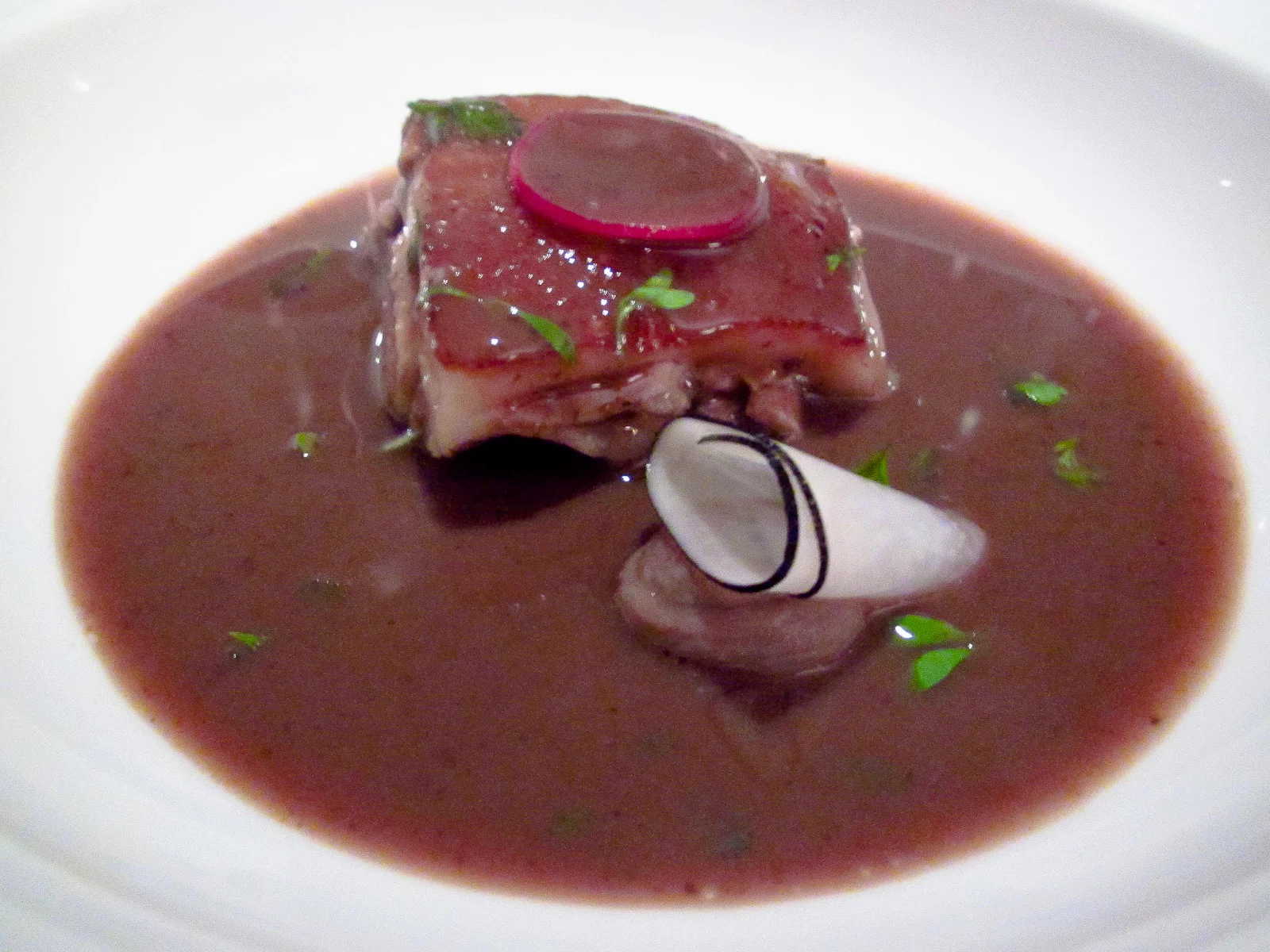Pujol
I've always liked Mexican food. But it wasn't until I actually visited Mexico, or more specifically met my girlfriend, that I learned what Mexican food really was. This was a cuisine without sour cream, chicken fajitas, "hard" shelled tacos, or tortilla salads. What I had thought was Mexican was actually Tex-Mex. Instead of piling on generous toppings as a mountain of salsa, guacamole, and cheddar cheese, the tacos I encountered were thin, delicate, and rarely adorned with more than a single sauce. In fact all the antojitos were smaller and simpler in comparison. On the other end of the spectrum, I learned, were the elaborate moles which sometimes have over a hundred ingredients. This is a country whose immense diversity of food spans from north to south, from the street into the restaurant. What makes Pujol special is its talented young chef, Enrique Olvera, who takes these nostalgic Mexican dishes, de-constructs, improves, and later re-assembles them for the dining room.
Baby corn "elotitos" - The concept of this dish comes from Mexican elote stands, a popular and delicious street food usually found outside supermarkets and zócalos. Traditionally an ear of corn is smothered in mayonnaise and dusted with queso fresco. Here, Olvera served baby corn brushed with chili mayonnaise and a sprinkle of queso fresco. The flavor was crispy, creamy, and slightly spicy with a hint of smoked chile. It lacked the sweet and juicy crunch whole kernels of corn have, but was tasty nonetheless. It was a miniaturized corn on the cob.
Ceviche de pescado a la veracruzana - Sashimi-grade slices of snapper, drizzled with vinegar and crowned with fresh olive and red onion. The concept here came from Mexican ceviche from the coastal region of Veracruz, where fish is so fresh it rarely touches a refrigerator. The thin slices of olive picked up on the dish's acidity, but since they were not acidulated themselves, added no sourness. They somehow made the fish sweeter. The texture of the fish was crunchy and lean.
Láminas de aguacate rellenas de camarón, mayonesa de chile puya, pesto de cilantro - Thin sheets of avocado sandwiching fresh shrimp and chili mayonnaise with coriander-infused olive oil. This was a simple and creamy plate where the freshness of the avocado sweetened the shrimp. The flavor combination was again reminiscent of coastal shellfish, always served with avocado, mayonnaise, and cilantro.
Tamal de cuitlacoche, espuma tibia de quesillo, salsa de tomate verde tatemado - Huitlacoche tamal with lukewarm quesillo foam and green tomato salsa. Huitlacoche, or what my friend the Ulterior Epicure calls "truffles of the south," is one of the grossest looking fungi I've ever seen. The same cannot be said of its flavor, however. With a dusty and dry texture, huitlacoche adds a gritty earthy hint to many rustic Mexican dishes. When ground and included in a tamal, it absorbs butter better than the cornmeal itself. In this deconstructed savory tamal, the flavors combine at once in the mouth to simulate the street-vendor experience. This was a particularly nostalgic dish for my girlfriend.
Sopa de chicharron con tortilla - This was not my favorite dish of the night. While I found its flavor and texture diverse, it tasted too common: it was nearly identical to tortilla soup available anywhere in Mexico. It was lacking an inspired creative twist.
Escolar en adobo oaxaqueño, cuitlacoche nixtamalizado, puré de chile poblano - I have never tasted a fish with this texture before. This deep-water fish had a texture similar to swordfish, but with a super-absorbent stringiness that squeezed out butter with each bite. It was playful to chew. This escolar was served with calcified corn and a poblano pepper puree. The corn added a fine layer of crunch while the puree a hint of vegetal spice. This was my favorite course of the night, and possibly a new favorite fish.
Frijol con lechón, rábanos picantes, consomé de frijol y hoja de aguacate - A fatty chunk of suckling pig with spicy radish and a bean consommé. This was outstanding. Not only was it the juiciest suckling pig I'd had, but it was surprisingly soft and delicate. The bean consommé was relatively light, allowing it to permeate every crevice of the meat. It made a juicy pig even more succulent.
Cremoso de limón, merengues de jamaica, frambuesa y betabel, arena de coco - Crispy hibiscus meringue atop lemon mousse with a raspberry and beet dusting. This was served with "coconut sand." This was my favorite of the two desserts; but it was very sweet.
Esponja de almendra, helado de manzanilla, leche de miel de acacia,puré de nanche amarillo - Almond sponge with chamomile ice cream, acacia honey milk, and nanche puree. This is a rendition of the classic Mexican dessert, Pastel de tres leches. I didn't like this; its flavor was too one-dimensional and cloying.
While this was a meal with many ups and downs, some of the dishes were really fantastic. When it comes to nostalgic cuisine, the US has Thomas Keller, the UK has Heston Bloomenthal; Enrique Olvera may very well be Mexico's representative chef.
This is the most innovative restaurant I've been to in Mexico City. Chef Enrique Olvera is really trying to bring Mexican cooking, one of the oldest and most diverse cuisines in the world, into the 21st century. Most importantly, he's doing this without losing focus of the food's roots, and that's no easy task. I can only imagine how this restaurant will continue to improve with time. It's definitely worth a visit.
















